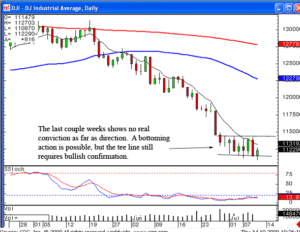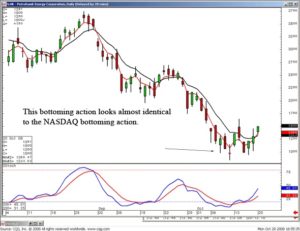Trading Stock for Beginners – Quick Introduction to Stock Trading
In today’s article we will discuss information that each and every investor should learn before investing in stocks. This article, Trading Stocks for Beginners, will take a look at how stock is valued, how to create a trading plan, and the types of trading methods that each investor should learn about before deciding how to invest their money.
Trading Stock for Beginners: How are stocks valued?
To make money investing in stock you need to buy stock at one price, and sell it at a higher price. The price of stock is determined by the perceived value of the stock based on two criteria. First, the value can be determined by the supply and demand of the stock. The supply and demand of stock is dependent upon the amount that investors are willing to pay for a share of stock and in return the amount that investors are willing to sell a share of stock. Second, a stock’s value is also determined by the price to earnings ratio.
Trading Stocks for Beginners: How do I create a trading plan?
When creating a stock trading plan, there are many components that should be included. In today’s article we will discuss three points that should be addressed in each plan, however a true trading plan will require a lot more information. The first part of developing a trading plan is determining your needs and your goals. Are you investing for the short-term of are you looking to practice long term investing? After reading today’s article “Trading Stocks for Beginners,” you will most likely come to realize that you need to set-up a brokerage account. What stock trading methods will you utilize to invest you money? Lastly, what is your budget? Many investors find themselves in a tough position because they don’t take the time to determine a budget based on money that they have. These investors will often find themselves investing with borrowed money.
Trading Stocks for Beginners: Which trading method should I utilize?
One of the most important parts of developing your trading plan is to determine how you will turn a profit when investing in the stock market. You will need to determine if you would like to practice fundamental or technical analysis. Through fundamental analysis the investors will assess the value of the company to determine if they would like to become a shareholder. They evaluate the company’s financial health, past stock prices, the economy and other factors. When researching other articles in addition to this article, Trading Stocks for Beginners, you will come to understand that fundamental analysts look to invest in the long-term as opposed to most technical analysts. Investors who utilize technical analysis typically look to practice short-term trading. They analyze trends and patterns in stock prices and use the volatility of the stock market to their advantage. Technical analysts are typically comprised of day traders and swing traders who will only own stock for hours to days as opposed to fundamentalists who own stock for a period of months to years.
Trading Stocks for Beginners: Conclusion
There is a lot of knowledge and training required to successfully trade stocks. Like with any new venture, “the more you give, the more you get.” This does not mean the more money you give, the more money you get back, but rather the more practice, training, and education that you receive, the more likely you are to succeed. There is a lot of information in addition to this article titled “Trading Stock for beginners” that you will need to research, but hopefully this article gets you pointed in the right direction.
Market Direction
Seasonality has many different definitions when it comes to investing. There are times of the year that will show a higher probability of the markets moving up or down. There are specific times of the year when certain sectors will act better than other sectors. For example, buying many of the toy manufacturers during the summer is a viable seasonality trade. The prices of stocks in that sector are usually much higher in January.
Seasonality is the result of reoccurring investment thought processes. Just as there are times that markets move well, there are other times when markets don’t move very well. The middle of the summer is one of those times. This is the result of many investors/traders taking time away from the computer screens. Volume diminishes dramatically. Trend direction tends to become more lethargic. This does not necessarily mean volatility diminishes. As we have seen in the Dow over the past two weeks, there has been good volatility on a daily basis while the overall trend has remained flat.

DOW
Having the knowledge of when it is most beneficial to be participating in the markets allows an investor to better allocate assets. Assets, in this case, do not necessarily mean investment funds. It can be applied to mental time and energy. Doing the same thing day in and day out requires energy. The continued draining of mental energy can create burnout. Everybody needs to take a vacation to rejuvenate. There are investors that become so involved with investing; they have to be participating in market trades all the time. But that continued involvement can diminish one’s mental clarity. When is the best time to rest and rejuvenate? When everybody else is resting and rejuvenating! It has been demonstrated that the summer months do not have the same investment profit potential as the other parts of the year, utilize that time for better pursuits. Can money be made during the summer months? Of course! But the opportunities may be fewer and far between.
The benefit of candlestick analysis is that it can pinpoint those few opportunities during the summertime. Even for the diehard investor, using candlestick signals during the summer months allows them to be participating in the sectors that ‘are’ getting attention. As demonstrated over the past month, the obvious sectors continue to act well. Oil stocks continue to maintain a bullish trend. Mining stocks are also performing well. This allows for simple trading strategies during the summer months. That strategy may be as simple as selling stocks in the oil sectors when they move away from moving averages and buying them back when they show buy signals during the uptrend.

HK
Applying candlestick signals to sectors that perform in specific times of the year allows the candlestick investor to put the probabilities of being in the right sector at the right time that much greater to their advantage. Do all sectors move the same way year after year? Obviously not, but they probably move in a certain manner a high percentage of the time to create their observance by the seasonality watchers. Candlestick analysis becomes an excellent confirmation of whether a stock/sector is going to perform in the manner that it is expected to. This again produces a high probability situation that can be expected, then observed using candlestick signals.
There are many investment strategies for making profits with candlestick signals. Use the simple and most effective ones for specific market conditions. Investing should be as simple as possible. Why make it complicated? Learn how to use the candlestick signals effectively. You then become the master of your own investment program. You also do not become a slave to your research program. Investing should be a process for making money in a timely manner, not spending hours and hours each day to produce profitable results.
Chat session tonight at 8 p.m. ET — open to everybody. Click here to Connect.
Good investing,
The Candlestick Forum Team
Because you are a preferred subscriber to The Candlestick Forum Newsletter you are eligible to take advantage of an Exclusive Limited Time Offer from Stephen Bigalow.
Website special reflects current newsletter. If you are reading an archived newsletter you will be directed to Current Website Special.
Speak Your Mind